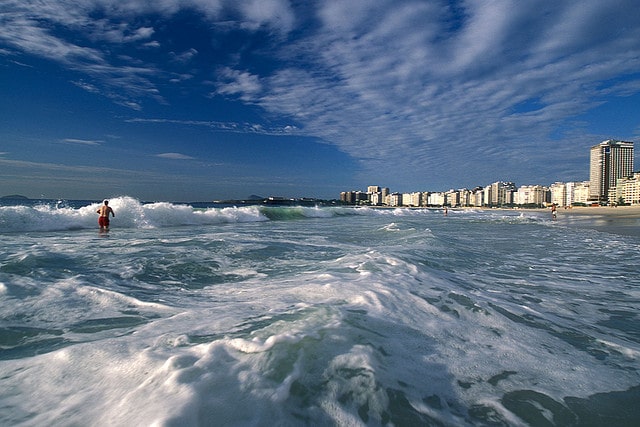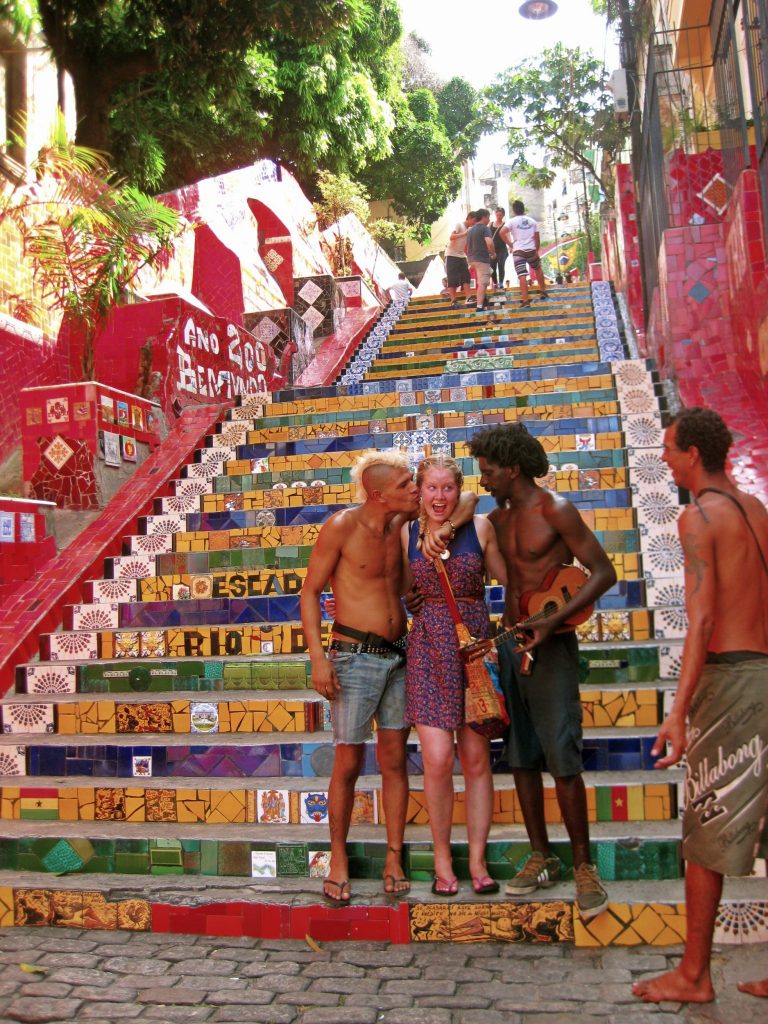
Rio de Janiero. A city of sexy shenanigans, where a vigilant Cristo watches the sparkling sequins of samba shows and sweaty, barely-clothed beach-goers from above. As much as I love the sand and sun, when my local friend, Rogerio, offers to show me around downtown Rio, I gladly accept his invitation.
Rogerio has an ambitious itinerary for our informal walking tour, with a variety of lesser known attractions and things to do in Rio de Janeiro: some semi-touristy, some best-kept-secrets and some cultural experiences. We weave between shoppers and skateboarders, buzzing by buildings reflecting a smorgasbord of architectural styles that bring together influences from around the world and across the ages.
Names of European and Brazilian artists encircle the exterior of the ornate Teatro Municipal, a glistening example of Belle Epoque architecture inspired by the Paris Opera house. A Roman-style Carioca Aqueduct — built in the 18th century to bring fresh water to the city — casts shadows on a plaza that now serves as a late night teen hangout, commonly known as the Lapa Arches.
For a reminder of Brazil’s darker past, we head to what was the world’s busiest slave trading port, the notorious Valongo wharf. As part of Olympic renovation efforts, the city recently unearthed the area, after purposefully burying it for two centuries, uncovering beads, bracelets and statuettes. Nearby in the famous Portuguese bakery Confeitaria Colombo, Rogerio introduces me to the chocolatey, condensed milk concoction of brigadeiro.
“You know how girls eat ice cream out of the carton when they break up with their boyfriends in American movies?” he explains, “This is the Brazilian version.”
I don’t need a nasty break-up to enjoy this treat, and I emerge from the shop with a sugar-high and chocolate covering my chin.

Constructed between 1800 and 1887, the Portuguese Royal Reading Room’s architecture and impressive collection transport the visitor to the 19th century. Photo courtesy of Katie Foote.
Little do I know, Rogerio has saved the best for last. After traversing a cobblestone path, we open the heavy wooden door to Gabinete Real de Leitura Portuguesa, a reading room that looks straight out of Beauty and the Beast. A stained glass skylight illuminates three stories of warm wooden shelves containing 350,000 books, including the largest collection of Portuguese works outside of Portugal.
“Positively magical,” I whisper. “And, I didn’t even tell you how much I love libraries”.
Rogerio nods. “I just stumbled upon it one day. Wait until you see what’s next.”
Winding our way back to the Lapa and Santa Teresa neighborhoods, we round the corner to a magical, mosaic staircase covered in over 2,000 tiles. According to the Rio Times, the artist, Jorge Selarón, left his home country of Chile at the age of seventeen, traveling to 57 countries before settling in Rio in 1983. Although trained as a painter with no experience in sculpture, he began the project decorating the stairs outside his home with tiles he fished out of the trash, broken mirrors and porcelain bathtub pieces.
Visitors began noticing the eccentric artist at work, decked out in board shorts, muttonchops and a bright red hat. When word about the project spread, inspired fans started sending tiles from over 60 different countries. Perusing the tiles, I find Michael Jackson, a meditating Buddha, the Playboy bunny, the Mona Lisa and even a hand-painted note to Selarón’s landlady, apologizing for neglecting to pay rent.

Rogerio, my amazing local tour guide and I, pose in front of one of the newer sections of the Escadaria Selarón. At the base of the stairs, the artist describes his vision for the ever-evolving “Escadaria Selarón,” vowing, “I will only end this mad and singular dream on the last day of my life.” Sure enough, Jorge Selarón was found dead on the steps in 2011, due to an undisclosed cause; however, his bohemian tribute to his favorite city has earned international acclaim, recently featured in Rio’s Olympic Bid video “The Passion Unites Us” (1:48), The U2 music video “Walk On” (1:55) and “Beautiful” by Snoop Dogg (0:25).

Selarón may no longer be alive but the staircase is full of friendly, eccentric artist-types, eager to share their songs, stories and beijos with visitors. Photo courtesy of Katie Foote
As much as I would love to swap stories with Selarón, the staircase still serves as a wellspring of inspiration for alternative artsy types. Some punk-rock teens serenad me with a ukulele and I earn bonus beijos (kisses) for stopping to listen. A couple years before his death, Selarón declared, “I made the most fantastic staircase ever in the history of humanity. In Rio de Janeiro! Because it couldn’t have happened in any other city!”
There’s something about Rio that captures the heart and imagination of even the most intrepid travelers. Even if you can’t score tickets to the 2014 World Cup or the 2016 Summer Olympics, Rio de Janeiro attractions are worth seeing, especially if you take the time to explore less-traveled landmarks.
Last featured image via vincentraal.
POST Contributed by writer Katie Foote who is a doctoral student who loves exploring the world every chance she gets. Top image credit: Rio de Janeiro’s famous Copacabana Beach. Photo courtesy of laszlo-photo.

Jessica Festa is the editor of the travel sites Jessie on a Journey (http://jessieonajourney.com) and Epicure & Culture (http://epicureandculture.com). Along with blogging at We Blog The World, her byline has appeared in publications like Huffington Post, Gadling, Fodor’s, Travel + Escape, Matador, Viator, The Culture-Ist and many others. After getting her BA/MA in Communication from the State University of New York at Albany, she realized she wasn’t really to stop backpacking and made travel her full time job. Some of her most memorable experiences include studying abroad in Sydney, teaching English in Thailand, doing orphanage work in Ghana, hiking her way through South America and traveling solo through Europe. She has a passion for backpacking, adventure, hiking, wine and getting off the beaten path.








